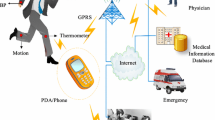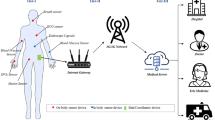Abstract
Wireless body area network (WBAN) is a promising methodology in present health care systems to monitor, detect, predict and diagnose the disease in people. The performance of the WBAN network is affected by un-trusted nodes in WBAN network. The un-trusted sensor nodes are formed in WBAN network due to the attackers from outside the world. In this paper, sensor node classification algorithm is proposed which incorporates ANFIS classifier based trusted and un-trusted sensor nodes detection and classification system is proposed inorder to improve the efficiency of the WBAN networks. This proposed system constitutes feature extraction and classification modules. The trust features are extracted from sensor nodes and these exracted features are optimized using genetic algorithm. The performance of the WBAN network is analyzed in terms of classification rate, packet delivery ratio and latency.





Similar content being viewed by others
References
Jing, L., Ming, L., Bin, Y., Wenlong, L.: A novel energy efficient MAC protocol for wireless body area network. China Commun. 12, 11–20 (2015)
Misra, S., Moulik, S., Chao, H.-C.: A cooperative bargaining solution for priority-based data-rate tuning in a wireless body area network. IEEE Trans. Wirel. Commun. 14(5), 2769–2777 (2015)
Walsh, M.J., Hayes, M.J.: Throughput rate control for an 802.15.4 wireless body area network using static and low order anti-windup techniques. In: Proc. Mediterranean Conf. Control Autom, pp. 1–6 (2007)
Ren, Z., Qi, X., Zhou, G., Wang, H.: Exploiting the data sensitivity of neurometric fidelity for optimizing EEG sensing. IEEE J. Internet Things 1(3), 243–254 (2014)
Yi, C., Wang, L., Li, Y.: Energy efficient transmission approach for WBAN based on threshold distance. IEEE Sensors J. 15(9), 5133–5141 (2015)
Kelly, F., Maulloo, A., Tan, D.: Rate control in communication networks: Shadow prices, proportional fairness and stability. J. Oper. Res. Soc. 49(3), 237–252 (1998)
Bae, J.N., Choi, Y.H., Kim, J.Y., et al.: Efficient interference cancellation scheme for wireless body area network. J. Commun. Netw. 13(2), 167–174 (2011)
Wang, L., Goursaud, C., Nikaein, N., et al.: Cooperative scheduling for coexisting body area networks. IEEE Trans. Wirel. Commun. 12(1), 123–133 (2013)
Cheng, S.H., Huang, C.Y.: Coloring-based inter-WBAN scheduling for mobile wireless body area networks. IEEE Trans. Parallel Distrib. Syst. 24(2), 250–259 (2013)
Alam, M.M., Berder, O., Menard, D., Sentieys, O.: TAD-MAC: traffic-aware dynamic MAC protocol for wireless body area sensor networks. IEEE. J. Emerg. Sel. Topics Circ. Syst. 2(1), 109–119 (2012)
Kumari, P., Anjali, T.: Securing a body sensor network. In: 2017 9th International Conference on Communication Systems and Networks (COMSNETS), vol. 12(8) (2017)
Kim, B.-S., Kang, S.Y., Lim, J.H., Kim, K.H., Kim, K.-I.: A mobility-based temperature-aware routing protocol for wireless body sensor networks. In: 2017 International Conference on Information Networking (ICOIN), vol. 7(22) (2017)
Jijesh, J.J. Shivashankar,: ” A survey on wireless body sensor network routing protocol classification. In: 2017 11th International Conference on Intelligent Systems and Control (ISCO), vol. 5(11) (2017)
Wang, Z., Yang, N., Guo, M., Zhao, H.: Human-human Interactional synchrony analysis based on body sensor networks. In: IEEE Transactions on Affective Computing, vol. 12(23) (2017)
Sulimov, A.I., Karpov, A.V., Lapshina, I.R., Khuzyashev, R.G.: Analysis and simulation of channel non-reciprocity in meteor-burst communications. IEEE Trans. Antennas Propag. 65(4), 2009–2019 (2017)
Liu, Y., Chen, Q., Tang, X., Cai, L.X.: On the buffer energy aware adaptive relaying in multiple relay network. IEEE Trans. Wirel. Commun. 16, 6248–6263 (2017)
Peng, H., Tian, Y., Kurths, J., Li, L., Yang, Y., Wang, D.: Secure and energy-efficient data transmission system based on chaotic compressive sensing in body-to-body networks. IEEE Trans. Biomed. Circ. Syst. 11(3), 558–573 (2017)
Sun, S., Gong, J., He, J., Peng, S.: A spreading activation algorithm of spatial big data retrieval based on the spatial ontology model. Cluster Comput. 18(2), 563–575 (2015)
Yu, R., Mak, T.W.C., Zhang, R., Wong, S.H., Zheng, Y., Lau, J.Y.W., Poon, C.C.Y.: Smart healthcare: cloud-enabled body sensor networks. In: 2017 IEEE 14th International Conference on Wearable and Implantable Body Sensor Networks (BSN) (2017)
Sun, Y., Wong, C., Yang, G.-Z., Lo, B.: Secure key generation using gait features for body sensor networks. In: 2017 IEEE 14th International Conference on Wearable and Implantable Body Sensor Networks (BSN) (2017)
Stollenwerk, A., Sehl, F., Marx, G., Kowalewski, S., Janisch, T.: Enrichment of a diving computer with body sensor network data. In: 2017 IEEE 14th International Conference on Wearable and Implantable Body Sensor Networks (BSN) (2017)
Samanta, A., Misra, S.: Energy-efficient and distributed network management cost minimization in opportunistic wireless body area networks. IEEE Trans. Mobile Comput. 17, 376–389 (2017)
Boudargham, N., Bou Abdoy, J., Demerjianz, J., Guyeuxx, C., Makhoul, A.: Investigating low level protocols for wireless body sensor networks. In: 2016 IEEE/ACS 13th International Conference of Computer Systems and Applications (AICCSA) (2016)
Zhao, B., Gu, Y., Ruan, Y., Chen, Q.: Two game-based solution concepts for a two-agent scheduling problem. Cluster Comput. 19(2), 769–781 (2016)
Sandhya, R., Sengottaiyan, N.: S-SEECH secured-scalable energy efficient clustering hierarchy protocol for wireless sensor network. In: International Conference on Data Mining and Advanced Computing (SAPIENCE) (2016)
Author information
Authors and Affiliations
Corresponding author
Rights and permissions
About this article
Cite this article
Kalaiselvi, K., Suresh, G.R. & Ravi, V. Genetic algorithm based sensor node classifications in wireless body area networks (WBAN). Cluster Comput 22 (Suppl 5), 12849–12855 (2019). https://doi.org/10.1007/s10586-018-1770-6
Received:
Revised:
Accepted:
Published:
Issue Date:
DOI: https://doi.org/10.1007/s10586-018-1770-6




